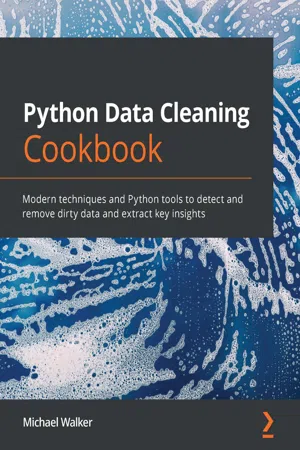
Python Data Cleaning Cookbook
Modern techniques and Python tools to detect and remove dirty data and extract key insights
- 436 pages
- English
- ePUB (mobile friendly)
- Available on iOS & Android
Python Data Cleaning Cookbook
Modern techniques and Python tools to detect and remove dirty data and extract key insights
About this book
Discover how to describe your data in detail, identify data issues, and find out how to solve them using commonly used techniques and tips and tricks
Key Features
- Get well-versed with various data cleaning techniques to reveal key insights
- Manipulate data of different complexities to shape them into the right form as per your business needs
- Clean, monitor, and validate large data volumes to diagnose problems before moving on to data analysis
Book Description
Getting clean data to reveal insights is essential, as directly jumping into data analysis without proper data cleaning may lead to incorrect results. This book shows you tools and techniques that you can apply to clean and handle data with Python. You'll begin by getting familiar with the shape of data by using practices that can be deployed routinely with most data sources. Then, the book teaches you how to manipulate data to get it into a useful form. You'll also learn how to filter and summarize data to gain insights and better understand what makes sense and what does not, along with discovering how to operate on data to address the issues you've identified. Moving on, you'll perform key tasks, such as handling missing values, validating errors, removing duplicate data, monitoring high volumes of data, and handling outliers and invalid dates. Next, you'll cover recipes on using supervised learning and Naive Bayes analysis to identify unexpected values and classification errors, and generate visualizations for exploratory data analysis (EDA) to visualize unexpected values. Finally, you'll build functions and classes that you can reuse without modification when you have new data.
By the end of this Python book, you'll be equipped with all the key skills that you need to clean data and diagnose problems within it.
What you will learn
- Find out how to read and analyze data from a variety of sources
- Produce summaries of the attributes of data frames, columns, and rows
- Filter data and select columns of interest that satisfy given criteria
- Address messy data issues, including working with dates and missing values
- Improve your productivity in Python pandas by using method chaining
- Use visualizations to gain additional insights and identify potential data issues
- Enhance your ability to learn what is going on in your data
- Build user-defined functions and classes to automate data cleaning
Who this book is for
This book is for anyone looking for ways to handle messy, duplicate, and poor data using different Python tools and techniques. The book takes a recipe-based approach to help you to learn how to clean and manage data. Working knowledge of Python programming is all you need to get the most out of the book.
Frequently asked questions
- Essential is ideal for learners and professionals who enjoy exploring a wide range of subjects. Access the Essential Library with 800,000+ trusted titles and best-sellers across business, personal growth, and the humanities. Includes unlimited reading time and Standard Read Aloud voice.
- Complete: Perfect for advanced learners and researchers needing full, unrestricted access. Unlock 1.4M+ books across hundreds of subjects, including academic and specialized titles. The Complete Plan also includes advanced features like Premium Read Aloud and Research Assistant.
Please note we cannot support devices running on iOS 13 and Android 7 or earlier. Learn more about using the app.
Information
Chapter 1: Anticipating Data Cleaning Issues when Importing Tabular Data into pandas
- Importing CSV files
- Importing Excel files
- Importing data from SQL databases
- Importing SPSS, Stata, and SAS data
- Importing R data
- Persisting tabular data
Technical requirements
Importing CSV files
Getting ready
Table of contents
- Python Data Cleaning Cookbook
- Why subscribe?
- Preface
- Chapter 1: Anticipating Data Cleaning Issues when Importing Tabular Data into pandas
- Chapter 2: Anticipating Data Cleaning Issues when Importing HTML and JSON into pandas
- Chapter 3: Taking the Measure of Your Data
- Chapter 4: Identifying Missing Values and Outliers in Subsets of Data
- Chapter 5: Using Visualizations for the Identification of Unexpected Values
- Chapter 6: Cleaning and Exploring Data with Series Operations
- Chapter 7: Fixing Messy Data when Aggregating
- Chapter 8: Addressing Data Issues When Combining DataFrames
- Chapter 9: Tidying and Reshaping Data
- Chapter 10: User-Defined Functions and Classes to Automate Data Cleaning
- Other Books You May Enjoy